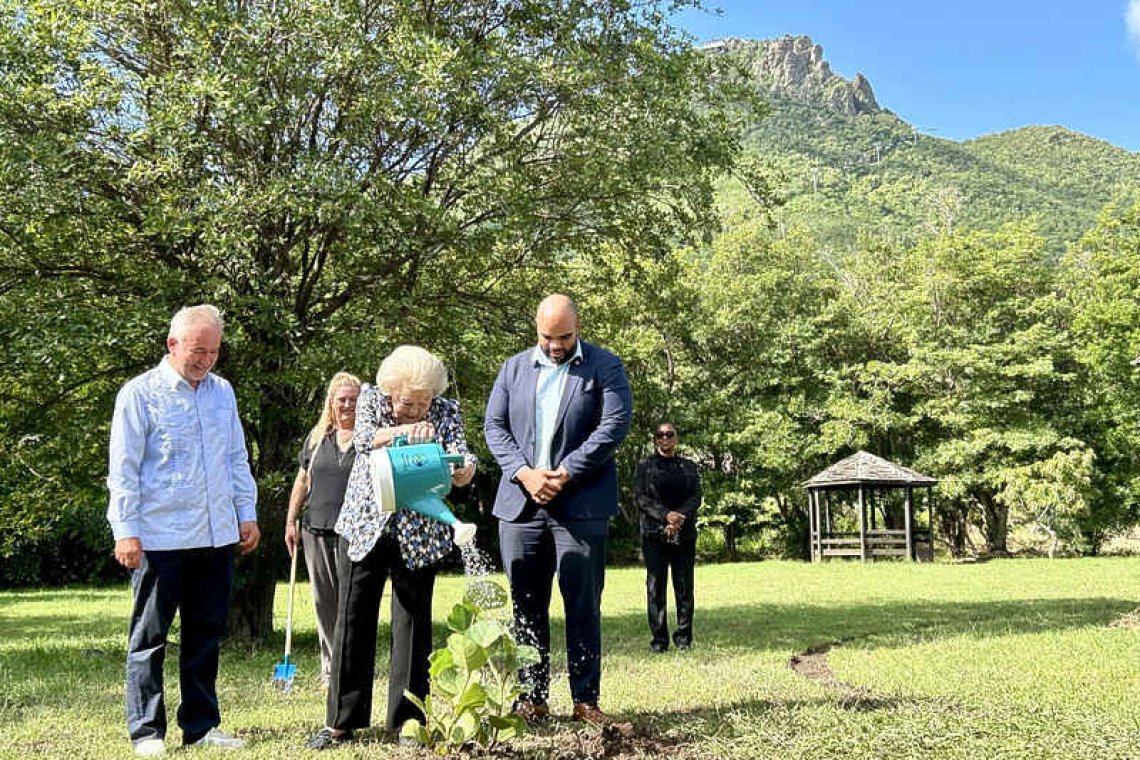Princess Beatrix planted a native sea grape tree at Emilio Wilson Park on Wednesday morning as a symbol of the importance of nature conservation, during her work visit to St. Maarten as patroness of Dutch Caribbean Nature Alliance (DCNA). From left: DCNA Director Arno Verhoeven, Nature Foundation Director Leslie Hickerson, Princess Beatrix and Minister of Public Housing, Spatial Planning, Environment and Infrastructure VROMI Patrice Gumbs.
PHILIPSBURG--The first full day of Princess Beatrix’s work visit to St. Maarten as Dutch Caribbean Nature Alliance (DCNA) patroness was dedicated to nature conservation and education.
The former queen attended a spoken word event and planted a sea grape tree at Emilio Wilson Park, participated in a marine spatial planning lesson at Milton Peters College, and visited the Perpetual Plastics project.
Armed with her Nordic walking poles, Princess Beatrix braved the muddy terrain at Emilio Wilson Park on Wednesday morning, November 13. Here, DCNA promoted youth education through a spoken word showcase, where young voices shared their inspiring stories, poems and monologues on the threat of invasive species and the vital role of nature conservation.
The choice of venue was symbolic, as the former plantation is now dedicated to recreation and preservation of the island’s natural and cultural heritage. Princess Beatrix marked the occasion by planting a native sea grape tree at the park in the name of nature conservation.
After waving at Sister Magda Primary School pupils who lined L.B. Scott Road as the royal motorcade passed by, Princess Beatrix attended an insightful session on Marine Spatial Planning (MSP) at Milton Peters College (MPC) by Nature Foundation, as MSP is aimed at ensuring the sustainable use of the island’s marine resources while protecting its vital ecosystems.
After a brief presentation on the key lessons and challenges of MSP, students presented their plans to the princess. In a role play activity, they explained how they represented the various stakeholders such as shipping companies, nature organisations and fishermen, and how they had negotiated to come to their marine spatial plan.
Princess Beatrix engaged with the students, asking them questions in both Dutch and English about the areas they wished to protect and the challenges they faced in coming to a beneficial solution for all stakeholders.
Finally, Princess Beatrix visited the Perpetual Plastics project initiated by Environmental Protection in the Caribbean (EPIC) St. Maarten, which focuses on recycling plastic waste into practical, reusable products.
The princess met Nature Foundation’s Junior Rangers at the Cole Bay workspace, with whom she discussed the importance of reducing and recycling plastic waste. In an interactive educational game, Princess Beatrix and the Junior Rangers selected cards with plastic products from a glass bowl, for which they had to come up with more sustainable alternatives. When she drew her card, the princess suggested that people use ceramic plates instead of plastic plates to reduce plastic waste.
The Junior Rangers also showed the patroness the items they made reusing plastic: for example, a pink piggy bank and a handheld fan that could be used during a power outage – both made from plastic bottles. The princess applauded the students for their creativity in transforming waste into fun products, and even tried her hand at shredding some plastic for recycling purposes.







